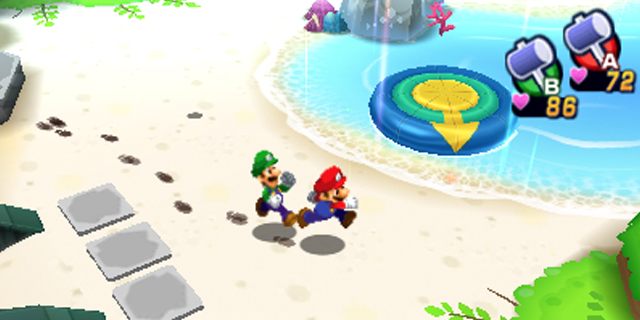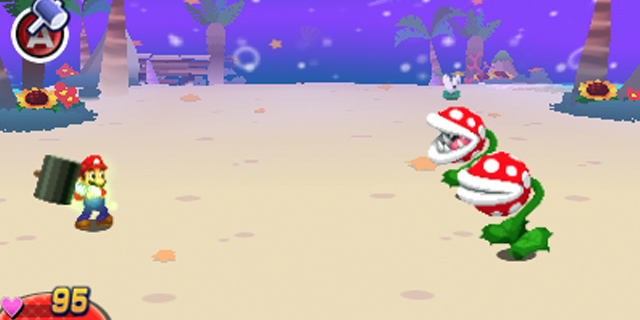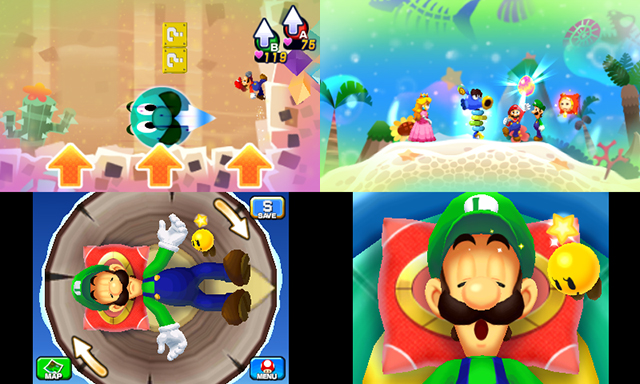
The Mario & Luigi series technically started on the GBA with Superstar Saga, but the argument could be made that the series is the successor to the SNES’s Super Mario RPG: Legend of the Seven Stars. The battle systems are similar, the aesthetic is familiar and the Paper Mario series is definitely off doing its own thing. Either way, Dream Team lives up to the legacy laid out by Superstar Saga, Partners in Time and Bowser’s Inside Story before it.
Mechanically, Dream Team works like the other Mario & Luigi installments, save Partners in Time which had the player controlling four characters instead of the usual two. The battles start out as typical turn-based RPG fare: take turns, jump on this, hammer that, use your mana-equivalent to unleash super moves and use consumables to restore health.
The twist comes in making the combat more active than passive. It’s not enough to select jump and wait for Mario to bop an opponent on the head; you can press A just as he strikes to do additional damage. Defense works the same way. Pressing A (for Mario, B is for Luigi) allows you to avoid damage and, in some cases, strike the enemy on his turn.

So far, I could have been describing Superstar Saga, and that’s okay, because Superstar Saga is a wonderful game that everybody should play. What sets Dream Team apart is Luigi’s role. Throughout the adventure, Mario and Luigi will come across special pillows for Luigi to use. Since he’s such a good sleeper, taking a nap on one creates a portal to the dream world.
Here, the world becomes two-dimensional, and Luigi takes a starring role. His dream equivalent, Dreamy Luigi, joins Mario in combat, and he can inhabit certain background elements to help Mario with platforming and world-altering challenges. Sometimes Luigi changes into a tree that Mario can grab onto to reach higher ledges, other times he is able to blow elements like question blocks from the background to the foreground, and still other times he can change the gravity to facilitate reaching the goal.

Dream Team makes a couple of missteps that are baffling, though. Save blocks return, despite the ever-present save button on the touch screen. Why are they there? Was Dream Team originally envisioned as a DS game? Being able to save anywhere (except in the midst of battle) is great, particularly for a portable game, so continuing to train the player to only save at save blocks seems strange. Why am I pressing the right shoulder button to swap A and B from jumping to hammer attacks, when I have enough buttons to do both? And where is the challenge?
There is absolutely no penalty for failure here. Lose a fight? You’ll start at the beginning of that fight, and the game will ask if you want to lower the difficulty. Dream Team may be aimed at a younger audience, but it is perfectly okay to stumble over a new enemy type without the game recommending ratcheting down the difficulty. This is a game with a battle system that relies on player skill, and the lack of consequences flies directly in the face of that. I don’t want every game to be “NES hard,” but I miss the days when I had to revert to an old save when I was genuinely nervous about making it to the next area or defeating a boss.
Mario & Luigi: Dream Team is fun, bright and everything you’d expect from a new entry in the series. The adventure will last you around 30 hours, the environments are well-crafted and the combat is fun. I just wish that there were some penalty for failure to make the novel combat system more worthwhile. Dream Team is fun, and some of the concepts are novel, but AlphaDream hasn’t unseated Bowser’s Inside Story as the best Mario & Luigi game.
Pros: Fun combat, interesting uses of Luigi in the dream world, lengthy adventure
Cons: Odd dual save system, strange button-mapping, no penalty for failure



















